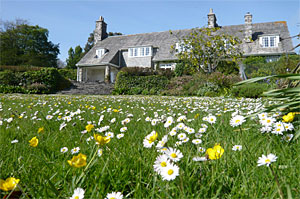Having stayed in the early days at The Haven, and then rented Linkside in subsequent summers, Ernest Betjemann decided in 1928 to build his own house in Trebetherick. Undertown was designed by the architect Robert Atkinson, a golfing chum of Ernest’s – as “a last blast of Arts and Crafts” in the words of his granddaughter Candida Lycett Greeni. Atkinson was responsible too for the design of Grey Ladies and Grey Gables, as well as the houses in The Close – all on land then belonging to Ernest Betjemann. He was also architect of the first Odeon cinemas.

Mrs Nell Oakley relates in her memoirsii how Ernest Betjemann “sent down beautiful walnut blocks for the parquet flooring of the sitting room, leaving it to the builders to lay them… To their horror when they [owner and architect] next came down they found that every block had been screwed down by the builder, who had probably never seen a parquet floor in his life… This was unforeseen sacrilege.” She also complimented Mrs Bessie Betjemann’s skills as a gardener: “her garden was a joy to see”.
John Betjeman was not enthusiastic about the new house. In a letter of August 1929iii he was critical of “the old world floor and older world grate and the crazy paving and bits of brass and pewter … I wish to heaven it were more comfortable”. (As an aside, the same letter gives a revealing insight into a bygone age – “Bess [his mother] is infused with an idea that the maids have too much to do. We are almost reduced to making our own beds although I should have thought that three servants for three people was adequate”.)
Ernest Betjemann died in 1934 and in 1938 Bess Betjemann sold the house for £3,250. By then John seems to have become reconciled to Undertown. In a letter to his motheriv John writes – “Of course it is sad to think of poor Undertown no longer being ours and that we will no longer sit on that slate terrace and look across to Bray Hill. In fact I feel as though I had lost an important part of me … Goodbye St Enodoc, goodbye Corkscrew [his nickname for Elsie McCorkindale] and the Mablys and everyone.” (Again, the letter is perhaps of more interest as a revealing insight into John’s nature and state of mind in 1938 rather than for his specific views on Undertown; in the letter he refers to the “ruination” of Trebetherick and describes England as “no longer habitable – war or no war.”)
Undertown came into the ownership of the Gladstone family in 1956. At some stage during the post war period the house was extended at the eastern end. The present owners, Annabel and Guy Wilson, bought Undertown in 1983. (Guy’s parents had acquired a small cottage near St Teath in 1958 and he had come to know and love the area; he remembers learning to drive with his father on the disused second world war airfield at Davidstow at much the same time as he was being taught to sail at Rock [by Trevor Evans].) Initially Annabel and Guy used Undertown merely as a holiday home for themselves and their expanding family. Now retired, they spend between three and four months of the year at Undertown and their children, all grown up now, visit with their own friends as often as they can. The gardens have been restored, a new tennis court has been installed and a small wild flower meadow established between Undertown and Trefelix.
i The Perfect English Country House, Candida Lycett Green, Pavilion Books Limited 1991, p 167.
ii [Reference unknown]
iii John Betjeman – Letters volume one: 1926 to 1951, edited and introduced by Candida Lycett Green, Methuen London 1994, p 58.
iv Ibid, p 214.
